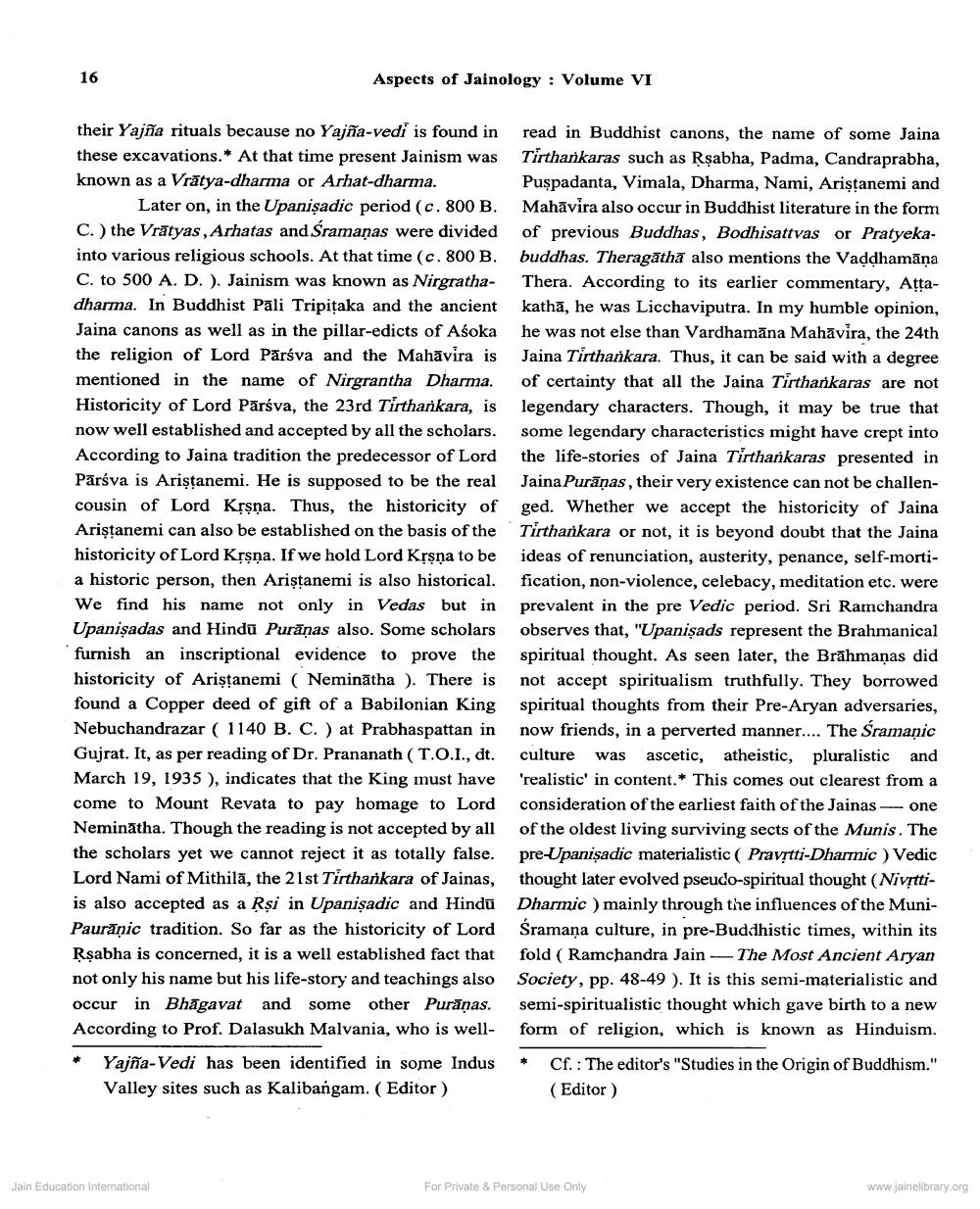________________
16
Aspects of Jainology: Volume VI
their Yajña rituals because no Yajña-vedi is found in these excavations.* At that time present Jainism was known as a Vratya-dharma or Arhat-dharma.
Later on, in the Upanisadic period (c. 800 B. C.) the Vratyas, Arhatas and Śramaņas were divided into various religious schools. At that time (c. 800 B. C. to 500 A. D. ). Jainism was known as Nirgrathadharma. In Buddhist Pāli Tripitaka and the ancient Jaina canons as well as in the pillar-edicts of Aśoka the religion of Lord Parsva and the Mahavira is mentioned in the name of Nirgrantha Dharma. Historicity of Lord Parsva, the 23rd Tirthankara, is now well established and accepted by all the scholars. According to Jaina tradition the predecessor of Lord Pārsva is Ariṣṭanemi. He is supposed to be the real cousin of Lord Kṛṣṇa. Thus, the historicity of Aristanemi can also be established on the basis of the historicity of Lord Kṛṣṇa. If we hold Lord Krsna to be a historic person, then Ariṣṭanemi is also historical. We find his name not only in Vedas but in Upanisadas and Hindu Purāņas also. Some scholars furnish an inscriptional evidence to prove the historicity of Ariṣṭanemi (Neminatha ). There is found a Copper deed of gift of a Babilonian King Nebuchandrazar ( 1140 B. C.) at Prabhaspattan in Gujrat. It, as per reading of Dr. Prananath (T.O.I., dt. March 19, 1935), indicates that the King must have come to Mount Revata to pay homage to Lord Neminatha. Though the reading is not accepted by all the scholars yet we cannot reject it as totally false. Lord Nami of Mithila, the 21st Tirthankara of Jainas, is also accepted as a Rși in Upaniṣadic and Hindu Paurāņic tradition. So far as the historicity of Lord
Rṣabha is concerned, it is a well established fact that not only his name but his life-story and teachings also occur in Bhagavat and some other Purāņas. According to Prof. Dalasukh Malvania, who is well
Yajña-Vedi has been identified in some Indus Valley sites such as Kalibangam. (Editor)
Jain Education International
read in Buddhist canons, the name of some Jaina Tirthankaras such as Rṣabha, Padma, Candraprabha, Puspadanta, Vimala, Dharma, Nami, Ariṣṭanemi and Mahavira also occur in Buddhist literature in the form of previous Buddhas, Bodhisattvas or Pratyekabuddhas. Theragatha also mentions the Vaddhamāṇa Thera. According to its earlier commentary, Aṭṭakatha, he was Licchaviputra. In my humble opinion, he was not else than Vardhamana Mahavira, the 24th Jaina Tirthankara. Thus, it can be said with a degree of certainty that all the Jaina Tirthankaras are not legendary characters. Though, it may be true that some legendary characteristics might have crept into the life-stories of Jaina Tirthankaras presented in Jaina Purāņas, their very existence can not be challenged. Whether we accept the historicity of Jaina Tirthankara or not, it is beyond doubt that the Jaina ideas of renunciation, austerity, penance, self-mortification, non-violence, celebacy, meditation etc. were prevalent in the pre Vedic period. Sri Ramchandra observes that, "Upanisads represent the Brahmanical spiritual thought. As seen later, the Brāhmaṇas did not accept spiritualism truthfully. They borrowed spiritual thoughts from their Pre-Aryan adversaries, now friends, in a perverted manner.... The Śramanic culture was ascetic, atheistic, pluralistic and 'realistic' in content.* This comes out clearest from a consideration of the earliest faith of the Jainas — one of the oldest living surviving sects of the Munis. The pre-Upanisadic materialistic (Pravṛtti-Dharmic) Vedic thought later evolved pseudo-spiritual thought (NivṛttiDharmic) mainly through the influences of the MuniŚramana culture, in pre-Buddhistic times, within its fold (Ramchandra Jain - The Most Ancient Aryan Society, pp. 48-49 ). It is this semi-materialistic and semi-spiritualistic thought which gave birth to a new form of religion, which is known as Hinduism.
Cf. The editor's "Studies in the Origin of Buddhism." (Editor)
For Private & Personal Use Only
www.jainelibrary.org




